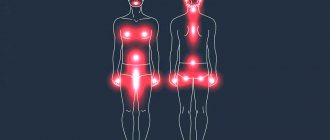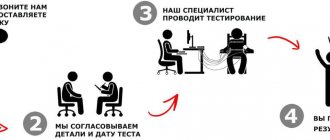A polygraph is a complex device designed to obtain information about the state of the body during testing of a person in order to find out whether the person being tested is telling the truth or lying. The lie detector is universal, applicable to any person, regardless of age and mental state. The main feature of the polygraph is to detect not the lie itself, but the reaction of the person being studied to the questions posed to him. The concept of reaction contains a large number of criteria, such as changes in respiration and blood pressure, pulse rate, and electrical resistance of the skin.
In the article you will learn how a polygraph works, get acquainted with the principle of its operation and its structure.
How does a lie detector (polygraph) work?
The one who admits to lying is always suspected more than the one who actually lies.
Lie detector (Deceiver)
- 1.Device diagram
- 2. Oscillograms
- 3. The principle of operation of the polygraph
- 4.Polygraph examination
- 5.Video: How a lie detector works
- 6.Relevance of using the polygraph
- 7. Factors affecting the test result
- 8.Results of the inspection
- 9.How the polygraph works: briefly
- 10.How to fool a lie detector
- 11. Reviews
- 12.Criticism
- CPD in the Ministry of Internal Affairs tests online - 2022 (with answers)
- Domino test in the FSB - online with answers
- How to pass a polygraph without problems: practical advice from experienced people
- How to take a polygraph test at the FSB: features of the process and important tips
- How legal is a polygraph test?
Device diagram
A polygraph is a complex composite device consisting of several elements.
The diagram and composition of lie detector devices is as follows:
- Sensors
_ Designed to monitor and obtain data on the psychophysiological state of the human body. - COMPUTER
. A computing machine, which in most cases is represented by a desktop computer. Records and processes received data from polygraph sensors. Subsequently, the computer converts the received information into an analog code and transmits it to the output device. - Output device
. An oscilloscope, printer, or monitor screen is used as such a device. These devices display the information received by the polygraph sensors on a diagram (polygram).
The period between the moments when data is received by the sensors and displayed on the diagram lasts ~600 ms (0.6 s); in fact, data on the state of the body is displayed in real mode.
Based on the results of analyzing the information on the diagram, the specialist makes a conclusion whether the answer of the person taking the polygraph test is true or false.
What is a polygraph
A polygraph is a technical device used to record psychophysiological reactions that arise in response to questions—stimuli—posed to him.
Attention! In ordinary life, many people call the device a lie detector.
The procedure is carried out by a polygraph examiner - a specialist with special education in the field of conducting research using a polygraph.
The main objective of the examination is to establish the reliability of the information provided by the person being assessed to the polygraph examiner.
Polygraph
Oscillograms
With the help of sensors, everything is recorded and displayed on a computer oscilloscope.
Regardless of a person’s desire, the reactions of his body give out all the truthful information. In this case, the facial expression may remain unchanged, the person may behave at ease, smile, assert, and give absolutely no indication that he is lying, however, he is unable to control the physiological reactions of the body. Moreover, they cannot be dulled even by taking super-strong doses of sedatives, a state of sleep or hypnosis, as well as a complete absence of fear or excitement.
The inability to consciously manage and control the reactions occurring in the body, their close connection with current information stored in memory, makes the survey method using a lie detector scientifically sound. This method is recognized as reliable and effective in identifying information hidden by a person in many countries around the world.
Video: Riddle on the train tracks
"Lie detector" and questions
The excitement that the device records in a person subjected to interrogation may have the most unexpected origin. An example is the case of checking a bank employee. “Detector” determined that the subject reacted unusually to the question: “Have you ever stolen money from a bank or its depositors?”
The strongest reaction was caused by the mention of the amounts of 800 and 1100 dollars. At first, the subject claimed that he had never taken such an amount, but then, confident in the omnipotence of the Lie Detector, he admitted to theft.
However, the bank manager was unable to detect any shortage. The young man was sent to a psychiatrist. And only then did it become known that not everything was going well in his family, that he felt guilty before his mother and wife for the fact that there was not enough money in the house, and we were talking about just the amounts mentioned.
Thus, the readings of the device did not indicate theft at all, but that the person was indirectly reminded of a problem that worried him.
In another case, to a simple question: “Do you drink coffee?” — the person quickly and truthfully answered “yes,” but the polygraph recorded a splash. With difficulty we managed to find out that in childhood this man was forbidden to drink coffee...
Obviously, almost any word can have additional emotional meaning for a person. Included in security questions, it can become a source of error that the operator will perceive as cheating.
There are other factors that lead to incorrect interpretation of polygraph records: some people sincerely wishful thinking; one person may turn out to be so “thick-skinned” that he does not even know what anxiety is, while another will be sensitive to the most seemingly innocent issues.
Lie detector and how the polygraph works
A man who for some reason does not like his name can become very aroused by truthfully saying “no” in response to the question: “Is your name Adolf Schicklgruber?” (Hitler's real name).
The device and tests can be considered quite effective and reliable if a survey of people on the same topic, conducted under different circumstances, gives approximately the same and reproducible results.
The same cannot be said about the lie detector. Moreover, when processing its readings, many circumstances are not taken into account, for example, even the temperature and humidity in the room where the “test” takes place.
Not to mention the wording of the questions, the tone in which they are asked, and everything else that can distort the result.
Experiment statistics
In the second half of the 20th century, one American researcher tried to test the objectivity of the “lie detector”. In a series of experiments, he suggested that operators use polygraph records to distinguish a thief from a simple witness to a crime.
This researcher stated that in only two of the 112 cases were innocent bystanders named as thieves. That the galvanic reaction of the skin gave the greatest accuracy - about 90% of guesses, and registration of the work of the heart and respiratory organs was less reliable - from 60 to 70 percent.
But here's another experiment: subjects who answered a series of questions were specifically instructed to lie twice. The operators detected both false statements only in 40% of cases, one of the two deceptions - in 48% of cases, and in 12 subjects, it turned out to be completely impossible to distinguish truth from untruth.
The situation was even worse when the interrogated deliberately used some kind of countermeasures; persistently thinking about some extraneous exciting events. They managed to reduce the accuracy of the “detector” readings from 75% of guesses to 25%, and by straining the muscles of the toes, they reduced it to 10%. There is hardly any need to comment seriously on this value.
The use of a lie detector also raises important ethical issues. The accused is told that the “machine” does not make mistakes, that is, they use lies to reveal lies.
Lie detector and how the polygraph works
A confession is sought from the accused by arousing in him fear of the device or instilling in him an incorrect idea about his testimony, that is, they are forced to testify. But this is prohibited by law...
There are approximately two to three thousand lie detector operators in the United States, most of whom have been trained in special courses. As a rule, they carry out “orders” from the Central Intelligence Agency and the Federal Bureau of Investigation.
But their services are also used by private companies, which check their employees from time to time. Most often, such a check is carried out on people applying for a job (in some states, laws have been passed prohibiting such questioning as a condition of employment, but there is no such ban for the entire country). The administration claims that people themselves agree to be checked by a “detector”.
But can such consent be considered voluntary? After all, refusal to take the test is seen as evidence of some kind of guilt, and this threatens with refusal to hire. Is such an invasion of privacy acceptable?
Truth serum
What is on the sober mind is on the tongue of the drunk.
In the thirties, the Texas doctor R. House, observing the effect of a strong sedative and analgesic - an alkaloid, noticed that with the intravenous administration of small doses of this drug, patients lose control of themselves, become overly sociable, friendly, complacent and, most importantly, frank - they blurt out what what people usually hide.
The medical representative shared his observations with police officials. Soon the drug (scopolamine) was accepted by the US justice system as a chemical “lie detector” called “truth serum.” Subsequently, the arsenal of investigators was replenished with other chemical substances that cause a state of severe intoxication (and, of course, are not harmless to health).
It is known that “truth serums” in some sense even exceeded the hopes placed on them: like drunks who are often uncontrollably boastful and, to put it mildly, prone to exaggeration, the accused weave tall tales, confess to crimes they had no idea about, and incriminate themselves and others.
It is curious that even some theoretical “justifications” were published with reference to the wisdom of the ancient Romans: in vino veritas - “the truth is in wine.” Or maybe they considered it an equivalent to the Russian proverb: “What is on the mind of a sober man is on the tongue of a drunken man.”
Julius Caesar and the chemistry of emotions
Adrenaline causes blood vessels to constrict, norepinephrine causes them to dilate. That is why a person turns pale with fear and red with anger. Apparently other physiological manifestations of emotion - dry mouth, changes in heart rate, etc. - are also controlled by chemical mediators.
Lie detector and how the polygraph works
Julius Caesar, presumably, knew nothing about the chemistry of emotions, but he perfectly knew how to distinguish those soldiers who turn pale with fear at the sight of the enemy from those who blush with anger. And in his army, as the ancient manuscripts say, he left only the second.
So even in ancient times it was well known about the different emotional effects of the same source of irritation on different people.
Fear or courage.
Even for the same person, the emotional reaction can be different depending on many factors: mood, weather, time of day. It depends on whether he is full or hungry, on his awareness of the nature of the stimulus and the surrounding environment.
The last circumstance is very important. After all, the emotion that the “lie detector” operator is counting on when asking a “critical question” is fear of exposure.
But practice has shown that it is precisely professional criminals, deprived of a sense of responsibility for their guilt and lies, if they are also confident that the investigator has no evidence, who most often do not give the expected reaction. They literally lie, don’t blush, their mouth doesn’t dry out, their palms remain dry, and their hearts beat evenly...
How the polygraph works
The principle of operation of a lie detector is based on the detection of microstress.
During the test, many sensors are attached to the human body in places where changes in blood pressure and breathing can be easily detected. The subject is then asked specially designed questions.
When a person gives a false answer, a reflex is triggered subconsciously, as a result of which blood pressure and breathing change. The subject becomes unable to control and restrain the body’s escalating physiological reactions.
The work of the polygraph is based on identifying and recording microstress in a person. There are many sensors attached to the human body that record sudden changes in the body's response. Sensors are attached to places in the body where changes in the psychophysiological state of the body are more clearly detected.
Key indicators observed by polygraph sensors:
- arterial pressure;
- breathing rhythm;
- increased heart rate;
- sweating
When all the sensors are installed, the person takes a test consisting of many questions.
For a high-quality polygraph test with a guaranteed result, the following conditions must be met:
- No noise or sudden movements
. Third-party activity distracts the person being tested by a polygraph, which affects physiological changes in the body, and therefore the sensor readings. - Simplicity of questions
. Basically, questions are asked with the answer options “yes” or “no”. More complex questions prompt a person to think more, which also leads to changes in the body. - Lack of amnesia
. If you lose your memory of the event or subject about which the question is asked, the polygraph result is invalid. If a person was a witness or participant in a situation, but does not remember anything about it, regardless of the answer of the person being tested, the required reaction of the body will not follow.
In the event of a knowingly false answer on the part of the person being tested, an unconditioned reflex is triggered at a subconscious level, which cannot be consciously controlled or prevented before it occurs.
The resulting reflex, in turn, creates a microreaction of the body, which is reflected in changes in the psychophysiological state. Even knowing how a polygraph works, it is impossible to deceive it, since the reason for revealing the truth is not in the lie detector, but in the functioning of the human brain - the detector only records the body’s reaction.
The sensor readings are transmitted to a computer, which converts the digital data into analog code, and then sends it to the output device.
Based on the results of the polygram analysis, a polygraph examiner with knowledge of the operation of a lie detector reports the manifestation of “truth” or “lie” on the part of the person being questioned. In this case, a person’s reaction may look completely calm, without changing his facial expression or averting his eyes; the interrogated person may not change his mood and calmly assert the truth on his part. However, it is impossible to control or restrain the physiological abilities of the brain.
The brain is not able to deceive itself and, regardless of a person’s desire or external factors, reproduces various reflexes in the case of truth and deception. The impossibility of conscious control of reactions and processes within the body, as well as their close dependence on current information stored in memory, gave scientific justification and recognition to the polygraph testing method.
Protopolygraphs: donkeys, roosters, bird eggs
Attempts to bring potential criminals to light were made long before the invention of the polygraph.
Our ancestors came up with a variety of means for this, and you can’t deny them their wit. Let's list the most interesting of them. "Pet the Donkey"
The suspect was to enter a dimly lit room and stroke the donkey's tail. If the animal screams, it means he is guilty. At least that's what the subject thought. In fact, the donkey’s tail was liberally smeared with paint, and guilt was determined not by the cry of the donkey, but by the cleanliness of the suspect’s hands: a real criminal would be afraid to pet the donkey (what if he screamed?). Approximately the same method was used in Rus', only there, due to the rarity of donkeys, they used a black rooster sprinkled with crushed coal.
Rice flour
During the investigation, rice flour was poured into the suspect's mouth. If after some time it remained dry, the person was declared guilty: it was believed that a real criminal would have a dry mouth from fear. This method was widely used in Ancient China, and later in Spain and England (only there rice flour was replaced by a piece of bread - the suspect had to eat it without noticeable effort).
bird egg
This method is also based on psychophysiological signs of fear - only different ones.
A quail egg (or any other with a delicate shell: a chicken egg will not work) was placed in the suspect’s hand. The real criminal's hands were shaking with excitement, and the fragile egg was cracking.
Gong
An elegant method from ancient India: the suspect, while quickly answering many questions about the details of the crime, had to rhythmically beat a gong at the same time. It was believed that if the subject was lying or hiding something, he would worry and disrupt the rhythm of the beats.
Pulse
This method, quite close in principle to the future polygraph, was already used by Avicenna. The wives who were suspected of infidelity were given the names of the men one by one, while the doctor measured the subjects' pulses. With the “right” name, the pulse - if the woman was guilty - supposedly should have increased. Much later, the writer Daniel Defoe proposed using the same method to expose criminals. In the 1730 treatise “An Effective Project for the Direct Prevention of Street Robberies and the Suppression of All Other Disorders at Night,” the author of “Robinson Crusoe” wrote: “... there is a shiver in the thief’s blood, which, if addressed, will expose him... Some of them are so stubborn in a crime that... even boldly meets the pursuer; but seize him by the wrist and feel his pulse, and you will discover his guilt.”
From here it was already half a step before the invention of the polygraph. The only thing missing was the technical means.
Interview with a polygraph examiner
During a polygraph examination of a subject, the device clearly records changes in all physiological parameters that occur in the human body when he answers.
Then, based on the reactions received, the specialist determines which of the questions the respondent gave a false answer to. To conduct testing, it is necessary to obtain written consent of the established form from the suspect (victim, witness). But since the data obtained are probabilistic in nature, they cannot be taken into account by the court as direct evidence of guilt or innocence.
Is the inspection legal?
Russian legislation does not prohibit polygraph examinations, so there is nothing illegal in offering to undergo them. But anyone can refuse them. And everyone who agrees to undergo polygraph testing signs a voluntary consent .
Whether to refuse or not depends on how interested the person is in this procedure. By rejecting an offer, for example, when applying for a job, a candidate may lose the chance to get the job he wants, since the employer may conclude that the applicant has something to hide. He cannot refuse a candidate on this basis, but choosing another is his right.
The relevance of the use of the polygraph
The lie detector is used in many areas, which is not surprising, because a polygraph test is currently the only way to verify the truth of a person’s words.
The polygraph is used in the following cases:
- Checking the company's staff
. Before making a decision to hire a new employee, serious corporations carry out a set of measures with him, including a lie detector test. A polygraph helps to find out in advance a person’s intentions and the purpose of employment, which is objective from a security point of view. - Investigation of crimes
. A lie detector helps to establish the guilt of a suspect in a crime. We especially use it in situations where a person’s guilt in committing a crime is obvious, but for bureaucratic reasons it is impossible to bring charges against him. - Special cases
. Lie detectors have also widely proven themselves to be useful in finding out the truth in individual cases, for example, when it is necessary to check the fidelity of a spouse. Today, in many countries, private companies offer human testing services using a lie detector.
Polygraph: myth and reality
Nowadays you can’t find a person who hasn’t heard about the polygraph. Mostly, knowledge is gleaned from films about spies or on the web resources of companies that provide lie detection services. As you understand, the information from these sources is, to put it mildly, not entirely reliable. Legends and rumors often interfere with our work, so we decided to write the most honest material about the polygraph test, how it works, how the sensors work, and who becomes a polygraph examiner.
In order to pass a lie detector, you do not need to belong to law enforcement agencies or special services, as before. All you have to do is enter the request “take a polygraph” into any search engine and select the office closest to you.
Who you can check:
- Yourself for the purpose of self-justification . For example, a fur coat was stolen at work, they blame you, but you were not involved and want to prove it.
- Employee upon hiring . For example, the position implies financial responsibility, and you do not want to entrust such work to just anyone.
- An employee in the event of an emergency : theft in a company, information leakage, etc.
- A spouse on the subject of infidelity , a future groom or bride to identify the true motives for marriage.
- Teenagers over 14 years old.
Who cannot be checked:
- People with mental disorders.
- Pregnant women.
- Suffering from cardiovascular diseases, including hypertension.
- Teenagers under 14 years of age and after 14 without the presence of a psychologist.
- Law enforcement and intelligence officers.
Factors affecting the test result
There are four main reasons why the results of a lie detector test are considered biased:
- Location
. The test subject's body should not be distracted by external situations and phenomena not related to the test. - Time spending
. Based on the results of many tests, over ten years of observation, polygraph examiners have determined that the most favorable period of the day for taking a polygraph test is from morning to lunch. - Number of checks per day
. It is recommended no more than three checks by one polygraph examiner. - Psychotropic effects or alcohol/drug intoxication
. It is similar to the first reason, with the difference of a stronger impact on the psyche. Even if it is possible to test a person in the above-mentioned condition, the test results left by the polygraph on the polygram will be different.The results of testing a person in a state of passion are different from the results of a sober person due to a more inhibited reaction of consciousness in the first. Such results cannot be analyzed even by experienced polygraph examiners and are considered irrelevant.
And, by the way, during the New Year holidays, the polygraph and polygraph examiners do not work the same way as everyone else.) Do not try to test someone on these days.
In some Western countries that use lie detectors in legal matters, violation of any of the above points may lead to the cancellation of the test results and invalidate them.
How much does a lie test cost?
Prices vary depending on the region and complexity of the inspection. As a rule, the work of a polygraph examiner is most valued when examining marital infidelity and conducting official investigations - from 7 to 15 thousand rubles. Vetting when hiring personnel is cheaper, but the price is affected by the category of the employee. Line staff can cost 3 thousand rubles, and for checking a nanny or housekeeper you will have to pay 10-15 thousand rubles. Testing teenagers is special. Not every polygraph examiner has a psychological education, and the work itself - testing a teenager on a polygraph - is not the most pleasant experience.
Check results
According to statistics, conclusions drawn on the basis of a polygraph are of very high reliability (80–90%).
When the tactics of using a lie detector accurately implement the principle of selective influence, all conclusions turn out to be reliable. In addition to the image or word, the actions of the investigator and the person or object during its presentation for delay can also have such an impact. All this indicates the breadth of tactical coverage of situations in which a polygraph can be used.
The polygraph works when there is a subject and sensors that are attached to it. Afterwards, a record is made, all indicators are recorded, significant points are compared with insignificant ones. Then, based on all this, appropriate conclusions are drawn.
There are some difficulties in working with a polygraph. They consist in the fact that the person being tested is placed in unusual conditions.
The whole process resembles a medical examination, which causes the subject to become agitated. A so-called situational reflex arises, which the polygraph examiner needs to remove. To do this, they try to bring the test closer to natural conditions. Sometimes, specialists working with a polygraph try to make it so that there is no need to install sensors, and the person being tested does not even imagine that he is being tested at all.
The birth of the polygraph
...And one hundred and fifty years later they appeared.
In 1877, the Italian physiologist Angelo Mosso discovered that the readings of a plethysmograph - a device for measuring pulse and blood flow in blood vessels - could be used to determine whether a subject was frightened. Mosso, however, did not in any way connect his research with criminology.
A few years later, the famous Italian psychiatrist and criminologist Cesare Lombroso already used this discovery when interrogating suspects. Changes in their blood pressure were recorded on a chart using a hydrosphygmograph, the first lie-detection device. In his book The Criminal Man (1895), Lombroso describes, for example, the following case: he once interrogated a robbery suspect and found no change in his blood pressure when the case was discussed; however, when the subject was asked about a completely different crime, the pressure changed dramatically. As it turned out later, Lambroso was right: the suspect really did not rob anyone, but was guilty of stealing passports.
And in 1902, with the help of a plethysmograph, the innocence of a man who was accused of murdering a six-year-old girl was first established (his innocence was later convincingly confirmed by an investigation).
Research in the field of instrumental lie detection was continued by the American psychologist William Marston. During the First World War, he actively used them to combat German espionage. In 1917, Martson measured the blood pressure of seventy suspects and, based on this data, identified the thief of secret documents from the safe of a high-ranking American military man. The person indicated by Marston was soon indeed detained at the moment of handing over documents to a German agent.
A few years later, in 1921, American medical student and freelance police officer John Larson created the first portable prototype of the modern polygraph. Larson's device recorded several parameters at once: changes in blood pressure, respiration and pulse. It was Larson, by the way, who coined the term “polygraph” (strictly speaking, this word existed before, but in a different meaning: in the 19th century, this was the name for a machine for creating copies of handwritten texts). And in 1926, Larsen’s student Leonard Keeler modified the device, which at that time was already widely used by the police: he added a channel for recording skin resistance. Later, in the 1930s, Keeler also came up with a fifth channel that recorded the presence of tremor. Actually, these five channels are still considered basic in psychophysiological examination.
It would seem that the kingdom of justice has come. Now not a single criminal will escape punishment, and not a single innocent person will end up behind bars. What could go wrong?
How a polygraph works: briefly
Surely everyone has heard about lie detectors used in police investigations.
But sometimes people who are applying for a new job have to undergo a similar polygraph test (for example, some government jobs where the results of a lie detector test are required from the FBI or CIA). The main purpose of a polygraph is to see whether a person is lying when answering certain questions or telling the truth. When a person takes a polygraph test, 4 to 6 sensors are attached to his body. A lie detector is a machine that records multiple (“POLY-”) sensor signals on moving paper (“-GRAPH”).
Polygraph sensors usually record:
- breathing rate;
- pulse;
- arterial pressure;
- sweating
Sometimes the polygraph also records data such as reactions and movements of the arms and legs.
When a polygraph test begins, the examiner asks three or four simple questions to establish signal standards. Then real questions are asked to test the detector. During the interrogation process, all signals coming from sensors attached to the body are recorded on moving paper.
Before the test begins and after its completion, the polygraph examiner looks at the graphs and sees the nature of changes in important indicators as a result of the questions asked. Most often, significant changes (such as increased heart rate, increased blood pressure, increased sweating) indicate that a person is lying.
When a trained professional uses a polygraph, he can detect lies with high accuracy. However, due to the fact that the expert's interpretation is largely subjective, and people react to lies differently, a polygraph test is far from the most perfect method.
The whole truth about the polygraph (lie detector). Dispelling myths
Almost all of us have heard of a “lie detector” or “polygraph” - a set of equipment for detecting lies. However, I will tell you straight, everything that you have heard and everything that is described on the Internet is, by and large, bullshit: half of the articles are posted on the websites of companies that provide services in this area, and the other half are cheap publications collected from scraps of information on the Internet copywriters who have never even seen the equipment. And even on Wikipedia the article is about nothing! And in order to put an end to this issue and write the most objective article, I decided to take a polygraph myself. After a short search through advertisements in Yandex.Direct, I became interested in a company whose website provided fairly detailed information about their services, a description of the digital equipment they use, and an approximate price range that seemed adequate to me. I submitted a request through an online consultant. An hour later the polygraph examiner called me back and agreed to meet on Tuesday in their office on Dmitrovskoe Highway. After Tuesday arrived, I put 10 thousand in my pocket and headed to their office. Arriving at the office and talking for the first 5 minutes with the polygraph examiner, I realized that my choice was right: I ended up with a qualified specialist, very sociable, who willingly told me everything. Testing was carried out on equipment from the Lafayette LX4000 company, which has been producing professional equipment for polygraph examiners for over 40 years (since 1972).
What is a polygraph?
First of all, a polygraph is not equipment, but a complex consisting of an apparatus and a psychologist. Which component is more important is a rather complicated question.
Types of polygraphs
There are both analog and digital. The first ones have long been rarities, now they can only be seen in museums, and digital ones consist of a block to which sensors are connected, which in turn is connected to a computer on which special software is installed.
What is being measured
- Breathing in the chest area;
- Breathing in the abdominal region (diaphragm);
- Electrical conductivity of the skin;
- Blood filling in peripheral vessels;
- Heartbeat.
Additionally:
- Blood pressure sensor;
- Mat with sensors for the “fifth point”;
- Mat with sensors under your feet.
What they ask
Depending on the order: checks for theft, checking candidates for a position, or resolving intra-family issues, there is a template of questions that is tailored to the current check.
How long does the session last?
On average about 1.5 hours. Sometimes a little less, sometimes a little more - it all depends on the specific situation.
Reading accuracy
Usually they talk about 80%, however, in fact, the figure is at the level of 93-95%. That is, only 5-7 people out of a hundred are able to pass a polygraph so that the result is incomprehensible (pay attention to the phrase “the result will be incomprehensible”: that is, it will be ambiguous, on its basis it will not be possible to state the results unambiguously, but nevertheless, there will be some result). However, as they say, “for every tricky bolt there is a nut with a left-hand thread,” and more on that below.
Procedure
You sit down in a chair, they put sensors on you (they may put them on first, and then you sit in the chair), sit down comfortably and they tell you how you should answer the questions.
As a rule, test questions are asked first to calibrate the equipment. They ask questions to which the polygraph examiner knows the exact answer: your name, surname, what city you were born in, marital status, what city you are in, etc. You can answer “yes” or “no”, therefore, questions are asked like “Are you in Moscow now?”
You are given 15-20 seconds to answer, so you can think before answering. Further, after the polygraph examiner has an understanding of how the equipment should react with “honest” answers, they begin to ask basic questions like “did you steal $10 million?” As a rule, such questions are asked by surprise.
During the procedure, not only the moment when the answer sounds is recorded, but also the state before and after the answer, that is, the parameters of the body are constantly recorded.
Psychological pressure
It turns out that it is very strong: you will be asked the same questions, sometimes slightly paraphrased. If your reaction to a question is twofold, then you will be asked questions again and again, at different intervals, analyzing and comparing the results with each answer.
Is it possible to fool a polygraph?
In principle, yes, however, this requires long training. In short periods of 8-10 questions, on the fourth attempt, on the “numbers” test, I managed to falsify the result. However, it is important to understand that these were tests for 2 minutes and over a long distance, without special training it will be extremely difficult to control yourself: after all, you must control the excitement of the body throughout the entire test!
Numbers test
The cards have numbers written on them, they are easy to remember because they are: 11, 22, 33, 44, 55, 66. You pull out a card, remember the number and can keep it. Next, the polygraph examiner asks the questions “Is this the number 11?” etc., in a random order and you must answer “no” to all questions. In my case, the sensors of blood filling in peripheral vessels and electrical permeability did not give objective values; only my heart rate and breathing gave me away. By controlling my breathing, I was able to control my heart rate at the same time. To falsify the results, I constantly thought about another number and when another number was named, I consciously changed my breathing rhythm and increased my internal nervousness, due to which the polygraph examiner, based on the polygraph results, made an incorrect conclusion about the numbers on the card that I had. But, testing yourself for 1.5 hours, answering 300 questions is not an easy task and without quite lengthy polygraph training, passing it is extremely unlikely!
Dispelling myths
There are several myths on the Internet that you can pass a polygraph, but none of the described methods can be called effective.
Not getting enough sleep
Like, if you are tired, you will be calmer. Yes, you will be calmer, but the polygraph has a very high sensitivity and the device can be calibrated when the body’s reaction is low. Even if a person is tired, he still continues to give a reaction when he has to lie.
Drink alcohol
There is no efficiency either. If you drink a little, the equipment will be calibrated, and if you drink too much, so that your consciousness becomes clouded, then you will be sent home, you will be forced to take a polygraph again.
Pharmaceuticals
That is, the use of sedatives, such as Phenazepam, etc. The effect is the same as in the case of alcohol: in order for the body’s reaction to seriously decrease, you will need to pump yourself up well with pills, and here I’m not sure that with such a dosage you will achieve independently before the polygraph.
Increased agitation
As an option, drink coffee or energy drinks, and more. It is believed that due to increased excitement, the truth will be mixed with lies, but, in any case, you can’t trample against the body, and even after pumping up on caffeine, the body’s reaction in those moments when it is necessary to lie will be pronounced.
Put the button in the shoe
Excuse me, when are you going to press this button? With every question? Or when is it necessary to lie? Or maybe when you tell the truth? Or random?
In any case, the reaction to pain is a little different than when the body is excited, when you have to lie and when your answers determine whether you will get a serious position, or a lawsuit will be opened against you, or your wife will leave you, taking half of the property.
To whom does the polygraph react poorly?
It was very interesting to learn that the polygraph reacts extremely poorly in cases where the subject is asked questions in a language other than his or her best command.
In particular, many polygraph examiners refuse to work with those who do not speak Russian well: this is explained by the fact that a person begins to translate the question into his “native” language, then generates an answer, after which he translates it into Russian and answers “yes” or “no.” ", and in this procedure the truth is lost. Mentally abnormal. That is, patients with schizophrenia who suffer from hallucinations are those who do not distinguish the real world from the fictional one and who can inspire themselves with anything.
There is a category of “pathological liars,” but essentially they manage to pass the polygraph for the same reason as the people from the previous paragraph: by self-hypnosis they confuse their emotions.
An extremely rare category of people who are simply calm. For example, intelligence officers who, after long training, learned to pass polygraph testing.
A few words about the “nut with a left-hand thread” or what to do if the polygraph data does not allow you to give an objective picture?
And in this case, polygraph examiners have other methods.
Additional sensors
They are placed under the “fifth point” and under the feet. These sensors allow you to detect muscle tremors - rapid rhythmic contractions.
Nonverbal cues
Throughout the test, a camera is installed that films the subject and records facial expressions, muscle contractions on the face, etc. This is demonstrated in more detail in the series “Lie to Me,” and you can also read in Paul Ekman’s book “The Psychology of Lies.”
Handwriting test
A person is asked to write in free form something about himself, where he is from, how he came to the city, something about his loved ones, and then they ask him to describe the situation in his own words and you know, after that the handwriting begins to creep up or down, changes inclination of letters, font size, etc.
As I wrote above, a lie detector test is not only polygraph data, it is also the skills of a polygraph examiner and knowledge of psychology. Once I got my crown on after being able to falsify the results in previous tests, I was asked to take a name test. The task is simple: on a piece of paper I write 5 female names and among them the name of my sister, and the polygraph examiner’s task is to determine who exactly my sister is. And while I was filling out the names, the polygraph examiner looked at my sheet out of the corner of her eye. During the test, I tried to falsify the third name, however, in the end, the polygraph examiner calculated the correct name, and this is how she explained it:
“Usually, statistically, no one writes their name first. The second was similar to the first, but I thought about the last name for too long. Therefore, it was either the third or fourth name. Since I gave a more pronounced reaction to the third name, and I already knew that you give a specially enhanced reaction to incorrect answers, then the 4th option remains.”
That is, as soon as your first contact with a polygraph examiner begins, they immediately begin to monitor you, study your behavior and, based on this, create your psychological portrait.
Can polygraph data be used in court?
In principle, yes, but the polygraph data is only indirect evidence of guilt and, based on the polygraph data alone, they can neither convict nor release.
Circumstantial evidence usually helps investigators and interrogators understand which side to approach the case and where to find direct evidence and evidence for indictment or release. By the way, there are also certain requirements for a polygraph examiner: in addition to the appropriate education, the polygraph examiner must test at least 1000 people using a polygraph, and also have the appropriate certificate, only after which his data can be used in investigations or trials.
It would seem, why can’t all the technologies described above be used to make judicial decisions? There is such a term as “Brokaw Trap” (English: Brokaw hazard) - ignoring the individual speech and behavioral characteristics of a person when determining the degree of his truthfulness. The concept was introduced in 1985 by psychologist Paul Ekman in his book “The Psychology of Lying,” based on the reasoning of the famous American journalist and TV interview master Tom Brokaw about how he determines the insincerity of his interlocutor:
Any manifestations, in most cases clearly indicating deception, for some people may turn out to be only part of their usual behavior. I will call the possibility of misjudging such people the Brokaw trap. The verifier can always fall into this trap, especially if he is unfamiliar with the suspect and does not know his typical behavior.
Interpretation of results
Correct interpretation of the results is the most important thing in testing, and that is why the polygraph examiner must be a highly qualified psychologist.
Let me give you a small example
: you are an exemplary family man, an ordinary office plankton, you have a wife, a child and a mortgage. And so you were detained on suspicion of drug distribution. The judge ordered a polygraph test. You are covered in sensors and after the first harmless questions during which the equipment is calibrated, you are asked the question: “Did you distribute drugs?”And here you will be overwhelmed by a flurry of thoughts:
- Damn, I didn’t do anything wrong! - What if the polygraph makes a mistake? This happens! — What if the polygraph examiner is not qualified enough? - Can I really get a minimum of 8 years just like that, for no reason? - And the wife? How will she treat me? Will he remain faithful? Will it wait for me? - Mortgage! Who will pay it if I am imprisoned and given no time for anything?
And this flurry of thoughts will raise all the sensors on the polygraph, and if you answer “no” they will be like this (light red background)
That is why the qualifications of a polygraph examiner are important - so that he is able to distinguish an attempt to lie from a nervous overstrain.
That is why the tests take 1.5-2 hours, during which hundreds of questions are asked. Our meeting lasted about an hour, and as a result, I was quoted a cost of 4 thousand rubles, which turned out to be even lower than my expectations. I am extremely grateful to the XXX company and the polygraph examiner YYY (since the post is non-advertising, I am not naming names) for their time and detailed description of the technology.
Questions?
PS: I was so interested in this area that I agreed with my polygraph examiner about training and will start attending courses next week. Who knows, maybe in the future such abilities will be useful to defend the Motherland. Well, in general, it’s interesting what results can be achieved.
How to fool a lie detector
As already mentioned, the polygraph is actually impossible to deceive: it only registers changes, while the changes themselves to a false answer occur in the human body, caused by unconditioned reflexes of the central nervous system.
And yet, is it possible to hide a lie? Theoretically, yes, such a possibility exists. To conceal a lie, it is necessary to control and anticipate unconditioned reflexes even before they arise. The brain of an ordinary person is not capable of this, which was confirmed every time they tried to deceive the polygraph. The outcome of such attempts was a slight deviation in the test subject’s body parameters, but the overall picture of the results did not differ from the results of tests in which the test subject did not attempt to deceive.
Control of unconditioned reflexes is comparable to supernatural abilities. And such people really exist, but there are only a few of them in the whole world, and the chance of meeting a person with supernatural abilities is equal to the chance of an ordinary person becoming the mayor of a large city. These cases are unique and, if individual people have hidden abilities, their brain works differently, which is reflected in the test readings. In such cases, a lie detector test is considered more irrelevant than reliable.
Polygraphs of the future
It may seem that with the development of artificial intelligence, lie detection is about to enter a new era. More and more companies are making loud statements about the discovery of unprecedented technologies, which are supposedly much more reliable than standard psychophysiological examination. For example, the creators of one of the first AI-based lie detectors, Silent Talker, declare that their program analyzes the behavior of a suspect in forty parameters - from blink rate to head tilt angle - compares it with training videos and finds relationships that are elusive to the human eye.
But, firstly, the very idea that deception is necessarily reflected in facial expressions has not yet been proven by anyone.
Secondly, all studies purporting to confirm the success of Silent Talker are based on extremely small samples.
Another company, Neuro-ID, offers nothing less than recognizing a potential fraudster by the movement of a computer mouse when filling out a loan application on a bank website. Another startup sells Eye Detect software, which supposedly detects lies based on the movement of the speaker's pupils. And the company Discern Science is developing “frames” for airports that can analyze human behavior, recognizing the movements of facial muscles and the timbre of the voice. And this is only a small part of the examples.
But the results of none of these inventions have been confirmed by independent research. And the theories on which they are based are questionable. After all, there is still no evidence that there are certain accurate and objective parameters with which one can recognize a lie.
Reviews
The lie detection procedure is first of all a METHOD, and then the hardware... Lie detection professionals know this. But only PROFESSIONALS know THIS... The technique consists first of explaining a set of questions that will be tested, and not a single question. Moreover, the emphasis in these questions is on supposed details, and not in general terms, as non-professionals believe... And when the person being tested is already stimulated to receive these questions, he is asked to answer these DETAILED questions unambiguously truthfully or falsely... This preliminary work is the main work of the polygraph examiner pro. Then mother NATURE and genetics come into play when the truthfulness of answers to these questions begins to be verified using a polygraph. And if there is significance in hiding the truth in a specific issue on the topic being tested, then the genetics of ANY adequate and stimulated person will NOT go ANYWHERE and will DEFINITELY WORK... Why? Because he is ALIVE and adequate and understands what will follow the revelation of the TRUTH. Moreover, psychophysiological reactions MUST appear in a logical sequence of questions as each question is asked separately, then in an average value and in several comparative degrees... So, not everything is as simple as you think... Only an expert in lie detection can make a mistake in the methodology and testing , not a pro... It’s like using a doctor’s thermometer... If you don’t have the symptoms of the disease you described, then there’s no point in asking you about your body temperature. And even if you try to CONVINCE (deceive) the doctor that you now have a temperature, he will OF COURSE believe not your words, but the thermometer...? Valery Evgenievich Volkov, experienced polygraph examiner
Is it possible to fool a polygraph?
As they say, nothing is impossible. By spending a couple of months learning and honing techniques for bypassing a polygraph, you can train your body so that the lie detector will mislead the polygraph examiner.
The essence of bypassing a polygraph is to learn to control your emotional state. And you will have to do this not only during testing, but also in everyday life. Regularly and methodically, you will have to control your emotions.
During the test you may be asked hundreds of different questions. It will take months to control yourself. Ahead lies a long period of mastering the practices of meditation and pacification of one’s own emotions.
However, deceive the polygraph in another way:
- you have a natural gift - you are a professional actor, capable of acting authentically and believing in what you play - you have a very developed sense of self-control
Finally, if you are a psychopath and do not adequately perceive reality. People suffering from nervous and mental disorders find it easy to deceive a polygraph. They simply do not understand where is real and where is fictional.
In fact, to bypass the polygraph you only need one thing - to believe that you are telling the real truth (even if it is a lie) and to be calm as a boa constrictor. But people spend years training these qualities.
And besides, do you need such a skill? If you have something to hide from yourself, then maybe you just need to reconsider your worldview?
There was “no torture” with a polygraph in the USSR
It was as if there was no detector, but cases were solved using the technique, the KGB was working. In the USA and Europe, lie detection (light detection) has been used since the end of the 19th century. In the USSR, research began in the 1920s, when 19-year-old Alexander Luria became interested in associative experiments and “traces” of events from the past in human memory. The young researcher created an early practical technique, the “lie detector” model. He is the founder of neuropsychology in the USSR.
Alexander Luria (1902 – 1977)
In 1923, at the Moscow Institute of Psychology, he conducted research to determine the untruthful answers of criminals, dividing the subjects into two groups - those who knew the plot of the crime and those who did not know it. It was necessary to press a button and answer 70 words from a list, of which 10 were critical, related to the crime. Those who did not know the plot of the crime clicked almost equally on meaningful and neutral words, in contrast to those familiar with the plot.
Since 1927, Luria has investigated involvement in the murders, interviewing 50 people. Suspects took 24% longer to press the button for meaningful questions. Only Luria published serious research on psychological diagnostics in solving crimes. His book was even published in the USA. But, unfortunately, the Soviet authorities did not approve of such work; the possibility of practical application of his experience in forensic investigation was questioned.
In 1932, the technique was improved by Darro , but it was never further developed. In the 1930s, the continuation of Luria's research was regarded as pseudoscientific activity. However, like genetics, cybernetics.
Experiments with a kymograph, graphic recording of physiological processes (Moscow, Moscow State University, 1927).
The method of psychodiagnostics in criminal proceedings was regarded as barbarism, unacceptable psychological manipulation, and the possibility of distorting facts. Communist ideologists understood that with the help of a polygraph, hidden information and their real attitudes could be obtained from themselves. The criticism was based on such fear.
A. Vyshinsky and M. Strogovich actively opposed the use of the polygraph in the 30s , who assessed the polygraph as an absurd method and a violation of human rights. S. Rosenblat insisted on the inadmissibility of using the method in criminal proceedings. The polygraph was followed by a trail of means to force a person to give false testimony, almost an instrument of torture, which is used in the United States.
Keeler polygraph 3-channel “Keeler Polygraph” (USA; late 1960s).
In criminology textbooks before 1980, the dreaded “lie detector” was branded as a pseudoscientific method from bourgeois countries that was used against the advanced working class.
The method was revived in the 1960s, when one of the world's best intelligence services, the GDR intelligence service, failed. The agents were exposed using a polygraph. The KGB provided the information, and the introduction of the “pseudo-scientific” lie detector did happen. But the United States imposed an embargo on sales to Eastern Europe; there were no detectors or specialists in the USSR. But the structures of the Soviet KGB as well as the services of the GDR, Yugoslavia and Poland still used American polygraphs.
Experiments to identify hidden information in a person (Moscow, late 1960s). Source: polygraph-na-donu.ru
It took scientists and employees of operational agencies several years for there to be a serious impetus for the development of the method. On June 25, 1975, KGB Chairman Yuri Andropov signed an order to create a highly secret laboratory No. 30, which dealt with polygraph, research and methods, under the leadership of Major Yuri Azarov . A. Zanicheva, V. Naumov, V. Noskov worked on the methodology.
Prototype of a computer polygraph. Moscow, 1987 “Researched” – employee of laboratory No. 30, B.E. Fedorov, at the device - Yu.I. Cold
Scientists were required to have scientific justification, objective (quantitative) criteria for assessing physiological changes during testing, and taking into account the characteristics of the individual. Therefore, specialists moved away from foreign practice and worked to solve the assigned problems.
Azarov made a great contribution to the development of new approaches and domestic testing technology. He introduced “symptom complex of physiological reactions” and “psychophysiological phenomenon” into specialized vocabulary. The technique matured by the 1980s, such innovations were introduced as:
- metric (objective) system for assessing recorded physiological reactions;
- the use of plethysmography to monitor the dynamics of the cardiovascular system;
- registration of the soundtrack of questions and answers;
- auxiliary control questionnaires;
- test for assessing the significance of the version of V.K. Noskova;
- mixed type test.
In 1960, V. A. Varlamov (Krasnoyarsk region) created the first ink-squeaking polygraph in the USSR, and in 1986 he developed a computer detector. He is the author of such popular and unique in its functionality devices as Reef, Chris, Barrier (in 2003 Barrier-14 was recognized as the best in the world), and these are far from “Zhiguli”, such devices are relevant and effective to this day. He has worked with lie detectors for more than 40 years and has published many specialized scientific papers. In 1962, he introduced a system for contactless collection of psychophysiological information.
Varlamov Valery Alekseevich (1935-2012) and his polygraph Rif
By the mid-1980s, prototypes of modern computer polygraphs were created. New achievements in methodology were enshrined in the terminology - “special psychophysiological research using a polygraph” (SPFI), but it was not possible to introduce the research into criminology. Work on the method was classified in the USSR, and few specialists became familiar with it.
Later, various interpretations of the terms began to emerge one after another: “examination using a polygraph” (1999), “instrumental psychophysiological survey” (2001), “psychophysiological research (PFI) using a polygraph” (2004), “ instrumental lie detection" (2004). By the beginning of the 21st century, the polygraph slowly began to be introduced into personnel matters.
What does the history of the polygraph tell us?
The polygraph was a mystery, shrouded in darkness. The officials were afraid of him. The “secret” stamp accompanied new developments and techniques. The world's intelligence services were hunting for new developments in the field of lie detection. Specialists from various services, exchanging experiences, always sought to improve methods and learned to apply them from those who had already successfully tested. All of the above speaks about one thing - determining lies using a polygraph is a method that currently represents the highest practical value in this direction.
Manipulation of fear: how lies were determined in ancient times
Any modern housewife can try to check whether her husband is cheating by offering him uncooked rice for dinner, a popular ancient method. But the leaders and elders gave a true/false verdict, relying on their authority and wisdom. Not only spells, rituals, herbs were used, but also physiology - saliva, movements, pulse, breathing.
Already in Ancient China they tried to observe physiology. The accused took raw rice into his mouth, listened to the accusation, then the moisture content of the grains was determined: salivation from the fear of revealing the deception is significantly reduced. Dry rice means it's guilty.
Lie detection with rice in ancient China
In ancient India, they used observation of a suspect striking a gong. Neutral and significant issues regarding the case that was being investigated were announced. You had to immediately answer with the first word that came to mind, while simultaneously hitting the gong. The change in the rhythm and force of the blows indicated the truthfulness of the answers. And in the laws of Ancient India of the 5th century BC. Judges were required to pay attention to a number of signs of lying: licking the corners of the mouth with the tongue, changes in complexion and beads of sweat on the forehead, and peculiarities of speech.
In Africa, tremor was used - suspects had to pass a fragile egg in a circle. Whoever is guilty will crush it. Also, the tribes used to determine guilt by the smell of sweat - the leader danced around the suspects, sniffing each one.
And even the donkey was involved in the administration of justice. The person had to stroke the animal's tail, which was smeared with something, in a darkened room. It was believed that the culprit would be afraid to stroke him and his hands would remain clean. Donkey tail has found such use in different parts of the world.
In Ancient Sparta, they held a competitive selection of future warriors for training; they didn’t want to waste time on cowards. The young men stood over the cliff and answered the question whether they were scared or not. As a rule, only “no” sounded, but the fear was revealed by the pale face. It was used to determine whether a young man was fit for the army. In ancient Rome, people who blushed when asked provocative questions were hired as bodyguards. It was believed that they would not enter into conspiracies.
“Mouth of Truth” (1st century AD), a kind of ancient lie detector, Church of St. Mary. Most likely, this is the face of the deity of the son of Poseidon - Triton. A person suspected of lying had to answer questions only with the truth, putting his hand in his “mouth.” If he was lying, the stone deity would have to bite off his hand. According to some information, she was cut off by the executioner at the time of testimony, if guilt was proven and the person was lying. The “Mouth of Truth” terrified the suspects; they themselves confessed to what they had done, just so they wouldn’t have to stick their hand into the ominous maw.
Subscribe to the Telegram channel “Lie Detector in Business” https://t.me/hr_security about business personnel security, practical cases of working with personnel, risks in actions and life hacks of working with people.
The famous Persian physician of the 10th century, Avicenna, could reveal the deception by changes in pulse rate and blood flow in the artery. This was most in demand for accusing wives of adultery.
During the canonical Inquisition, gestures, facial expressions and emotions were included in the interrogation protocols; they could serve as evidence.
Daniel Defoe (1730) wrote that guilt entails fear, so a thief should take his pulse. In books of the late 20th century, a meter for psychological stress is often found.
The 18th century gave rise to the development of technology, prototypes of the modern polygraph.
When verification is not carried out
There are cases when it is really better not to take a polygraph test and refuse it yourself. This is especially true for situations where there is an understanding that, based on its results, the decision is unlikely to be positive, since there is a need to hide something.
A polygraph test is not carried out on a certain category of people, regardless of whether they are ready to take it themselves or not.
Testing will not be carried out if:
- the age of the subject is less than 14 years ,
- have mental illnesses and disorders,
- there are signs of physical and mental exhaustion: fatigue, chronic lack of sleep, prolonged stress,
- the subject is taking strong medications,
- the person is sick with cardiovascular diseases or has problems with the respiratory system,
- alcohol or drug intoxication was detected,
- a woman is expecting a child, especially in the second half of pregnancy.
The polygraph examiner will definitely clarify the questions regarding the existing restrictions, and therefore you need to respond to them absolutely calmly. He asks about this not because he wants to convict someone of something, but on the contrary, he strives not to do harm, since all the listed cases relate to the possible receipt of an unreliable examination result.
The polygraph examiner is obliged to clarify questions regarding existing restrictions on testing
This is interesting! How many employees can you have and is it possible to work two jobs officially?
Modern polygraphs
Today there are even contactless polygraphs without sensors that are attached to the body. In particular, at SSU named after. Chernyshevsky created such a device that reads and processes non-verbal data. But more accurate is, of course, the use of sensors. There are two types of polygraphs based on the methods of outputting and recording data:
- Analog (chart paper): Lafayette-761, Stoelting-80506. Practically not used, outdated.
- Digital (electronic recording on a PC): Axciton, Limestone, Paragon, Lafayette-LX4000, Stoelting-86225, Rubicon, Inex-polygraph, SPHERE, Barrier, Corsair, Chris, Katrina, RIF, Poliskor, Diagnoz, Diana, Concord, PIC, Archon, Polarg, Epic, Energy, Delta-Optima, Evero, KARDi, etc.
The American Lafayette Instrument Company produces about 80% of all polygraphs, created the first wireless digital polygraph LX5KM-SW, and produces polygraphs for the Pentagon.
What polygraphs record using sensors: skin resistance, galvanic skin reactions, heart dynamics, blood pressure and pulse, vascular filling, thoracic and diaphragmatic breathing, facial expressions, muscle activity on the face and body, voice vibrations. Video and audio recording is also carried out. The device continuously records, stores and processes these values of psychophysiological parameters.
How is testing carried out?
Polygraph testing consists of several stages.
- Meeting and getting acquainted with a polygraph examiner.
- A preliminary conversation in which the purpose of the inspection will be explained and the procedure will be explained. It is important to know that all questions that will be asked will be discussed. Until the polygraph examiner is convinced that the test taker knows and understands all the test questions, he will not begin the procedure itself.
- The person signs consent to undergo testing or refusal.
- If you agree, the testing phase begins. First, detailed instructions are given: how to behave, what not to do, sensors are put on, and questions are asked.
- During the tests, the polygraph examiner may have additional questions in connection with the reactions of the test taker. In this case, a second conversation is conducted, the information is clarified and changes are made to the test questions, and the test continues.
- At the end of the procedure, the polygraph examiner releases the test taker and processes the results obtained and prepares a conclusion.
This is interesting! Where is the labor exchange located - at your place of residence or registration?
Famous polygraph examiners of Ukraine
Polovnikova Zhanetta Yurievna . Polygraph examiner in. Since 1998, he has been investigating high-profile crimes. She compiled methods for the Ministry of Internal Affairs, the first Ukrainian manual for the Department of Internal Affairs. Member of the working group of the Ministry of Internal Affairs on the implementation of modern technologies and techniques in the practical activities of the internal affairs bodies of Ukraine. She studied at the Central Internal Affairs Directorate of the Krasnodar Territory. Candidate of Psychological Sciences, Academician of Law and Associate Professor of the Department of Criminal Law of the Ukrainian Technological Academy.
Chimisova Victoria Alexandrovna . A polygraph examiner has significant experience in successfully solving high-profile criminal cases related to property and finance. She studied at the Central Internal Affairs Directorate of the Krasnodar Territory. Tested more than 3 thousand people, polygraph examiner since 1998.
Rybalchenko Oleg Nikolaevich . Co-founder and deputy chairman of the College of Polygraph Examiners of Ukraine, full member of the Coordination Council of the College of Polygraph Examiners of Ukraine. Studied at the American International Polygraph Institute APA Chuck Slapsky. Director of the company “Personnel Security”. Checked more than 5 thousand people. Author of tests and methods, has published a number of teaching aids. Polygraph examiner since 2005.
Shapovalov Vitaly Alexandrovich . Head of the College of Polygraph Examiners of Ukraine, editor-in-chief of the College’s journal “Reliability Assessment: Scientific Research and Practice.” Author of “Methods for psychological assessment of the reliability of testimony in legal practice”, a number of scientific publications.
Usikov Igor Petrovich . Co-founder and first Chairman of the College of Polygraph Examiners of Ukraine in the period 2013-2016. Full member of the Coordination Council of the College of Polygraph Examiners of Ukraine. He specializes in conducting forensic examinations and has extensive experience working in the Ministry of Internal Affairs (1986 – 2006). Developed by the Ukrainian computer polygraph "SPHERE". Director .
Motlyakh Alexander Ivanovich . Leading researcher at the laboratory for problems of pre-trial investigation, Institute No. 1 of the National Academy of Internal Affairs. Honored Lawyer of Ukraine. Head of the Department of Criminal Law and Procedure at the National Aviation University, Professor of the Ministry of Education and Science of Ukraine, Doctor of Law. Practicing polygraph examiner since 2005.
Subscribe to the Telegram channel “Lie Detector in Business” https://t.me/hr_security about business personnel security, practical cases of working with personnel, risks in actions and life hacks of working with people.











